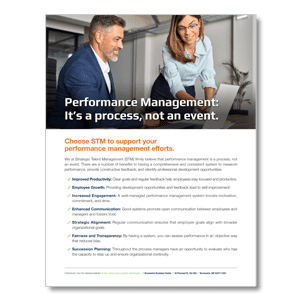Join STM’s Mailing List
Don’t miss any of our informative articles, news, or updates. Sign up to receive emails from STM today!
Rewriting the Talent Playbook: Why Expectations, Transparency, and Engagement Matter More Than Ever
In today’s volatile talent market, organizations cannot afford to rely on outdated hiring practices or generic job descriptions. Companies that succeed are those that intentionally align their hiring, onboarding, and performance strategies with clear expectations, transparent communication, and a culture of engagement.
At Strategic Talent Management (STM), people challenges are business challenges. Solving them requires more than checking boxes. It demands a strategic, human-centered approach that builds trust and delivers results from the very first interaction.
Job Descriptions Are Outdated. Job Expectations Drive Success.
Traditional job descriptions focus on listing tasks. Job expectations focus on defining outcomes. This distinction is critical for modern talent management.
STM emphasizes that job expectations clarify what success looks like in a role. Whether it’s expanding into new markets, revitalizing teams, or improving operational efficiency, expectations provide a roadmap for both hiring and performance management.
Vague job descriptions often result in misaligned hires and disengaged employees. Clear expectations empower candidates to self-select into roles where they can thrive and provide managers with a foundation for coaching and accountability.
STM Tip:
Before posting a job, define the top three to five outcomes the new hire must achieve in their first six to twelve months. Use these expectations to guide your interview questions and performance metrics.
Candidate Experience Shapes Your Employer Brand
In a competitive hiring environment, the candidate experience can either attract top talent or drive them away. STM research highlights that common missteps, such as omitting salary ranges from job postings or requiring complex applications, deter high-quality candidates.
A streamlined and transparent hiring process communicates respect and professionalism. Candidates should feel informed, valued, and excited about the opportunity from their very first interaction.
STM Tip:
Simplify your application process, provide clear information about compensation, and maintain timely communication with candidates throughout the hiring journey.
Engagement Starts Before the First Day
Employee engagement does not begin at onboarding; it starts during recruitment. STM’s research shows that early engagement through clear communication, cultural alignment, and meaningful interactions sets the foundation for long-term retention and performance.
Engaged employees are more productive, more satisfied, and more likely to stay with your organization. Disengaged employees, on the other hand, contribute to higher turnover, lower morale, and decreased performance.
STM Tip:
Invest in pre-boarding activities that connect new hires to your company’s mission, values, and team members before their official start date.
Pay Transparency Builds Trust and Reduces Attrition
Pay transparency is more than a compliance issue. It is a strategic tool for building trust and promoting equity. STM advocates for clear and consistent communication about pay structures to eliminate ambiguity and foster a fair workplace culture.
When employees understand how their compensation is determined and how they can influence it, they are more likely to feel valued and motivated. Conversely, a lack of transparency can lead to dissatisfaction, suspicion, and ultimately, attrition.
STM Tip:
Develop and share a clear compensation framework outlining salary ranges, bonus structures, and criteria for raises and promotions. Regularly review and communicate these frameworks to your team.
Performance Management Is a Process, Not an Event
An annual performance review is not enough. STM emphasizes that effective performance management requires continuous conversations focused on growth, feedback, and alignment with business goals.
Regular check-ins, clear expectations, and actionable feedback keep employees engaged and ensure that individual efforts are aligned with organizational objectives. This proactive approach also allows managers to address potential issues early.
STM Tip:
Implement a structured performance management system that includes frequent one-on-one meetings, real-time feedback mechanisms, and individualized development plans.
A Strong Culture Is Essential for Business Success
A positive and intentional workplace culture is the foundation of effective talent management. STM’s “Dos and Don’ts of Employee Engagement” highlights how trust, recognition, support, and work-life balance contribute to building an engaged workforce.
Organizations that prioritize culture see better performance, higher engagement, and lower turnover. Neglecting culture, however, leads to disengagement, burnout, and retention challenges.
STM Tip:
Continuously assess and reinforce your company culture through regular employee surveys, feedback sessions, and consistent leadership behavior that models desired values.
Take the Next Step with Strategic Talent Management
Your business success hinges on the strength of your people. Misaligned expectations, disengaged employees, and outdated performance and hiring practices are costly mistakes that companies can no longer afford. At Strategic Talent Management (STM), we partner with organizations like yours to solve people challenges with practical, proven solutions.
Whether you need to attract top talent, improve retention, or build a high-performance culture, STM provides the expertise, tools, and strategies to help you achieve your goals.
Ready to align your people strategy with your business objectives?
Let’s discuss your specific challenges and outline a customized action plan to improve hiring, engagement, and performance across your organization.


